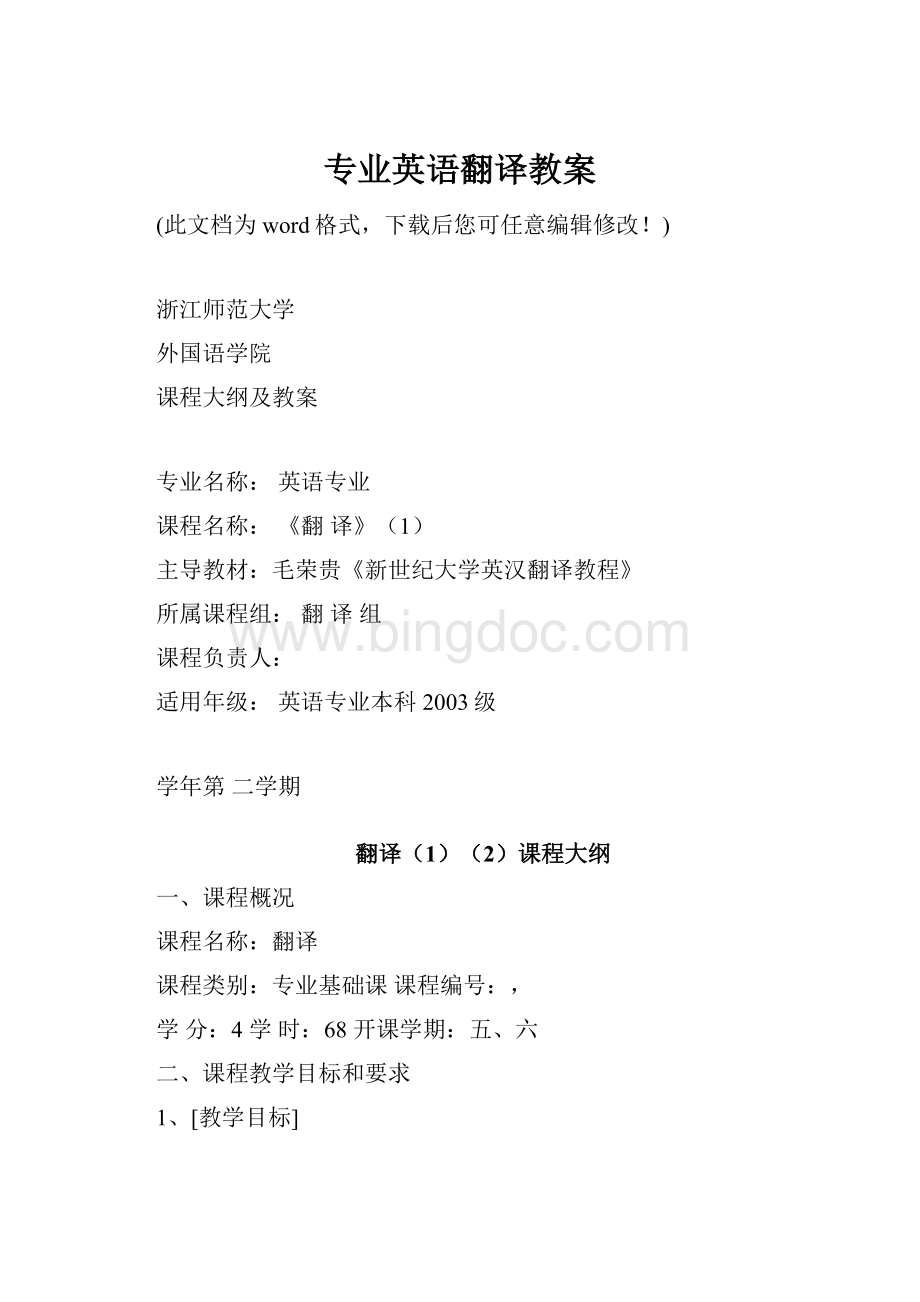专业英语翻译教案.docx
《专业英语翻译教案.docx》由会员分享,可在线阅读,更多相关《专业英语翻译教案.docx(76页珍藏版)》请在冰点文库上搜索。

专业英语翻译教案
(此文档为word格式,下载后您可任意编辑修改!
)
浙江师范大学
外国语学院
课程大纲及教案
专业名称:
英语专业
课程名称:
《翻译》
(1)
主导教材:
毛荣贵《新世纪大学英汉翻译教程》
所属课程组:
翻译组
课程负责人:
适用年级:
英语专业本科2003级
学年第二学期
翻译
(1)
(2)课程大纲
一、课程概况
课程名称:
翻译
课程类别:
专业基础课课程编号:
,
学分:
4学时:
68开课学期:
五、六
二、课程教学目标和要求
1、[教学目标]
通过本课程的教学,帮助学生有效提高翻译实践能力和理论认识,达到高等学校英语专业英语教学大纲对其翻译能力的基本要求,即:
能运用翻译理论与技巧,将英美报刊上的文章以及文学原著译成汉语,或将我国报刊、杂志上的文章和一般文学作品译成英语,译文忠实、流畅,译速每小时个英文单词汉字,使之可以胜任未来的中学英语教学以及其他涉及翻译能力的工作。
2、[课程要求]
本课程为系列专业基础课,由英译汉和汉译英组成,要求学生按顺序修读。
为达到课程教学的目的,采用讲练结合的方式,布置相当数量的课后作业要求学生按时按量完成,并积极参与课堂讨论。
三、教学内容与教学安排
1、[教学内容要点]
本课程教学以实践为主,理论为辅,重点是翻译技巧的介绍与练笔,翻译内容涉及各类文体、各个领域。
课程安排按照讲练结合的原则展开,帮助学生有步骤有针对性地训练翻译的基本技能。
通过大量的练习和讲评,强化学生对不同文本语体特点和翻译原则的认识,为其将来从事翻译工作或运用英语作为工作语言打下坚实的双语转换实践基础。
2、[教学安排]
本课程教学依据教学大纲,安排在本科三年级上、下两学期进行,共计68学时,其中36学时为英译汉,32学时为汉译英,每周2学时。
教学计划允许授课教师在具体操作中有一定的灵活度,但至少应包含以下3部分的主题内容:
1)翻译概述(含翻译的标准、原则、过程、中外翻译简史及翻译名家的主要观点等);
2)翻译技巧讲练(介绍主要的英汉互译技巧,结合学生的练笔进行讲评);
3)多视角的翻译实践与研究(不同领域的翻译实践及其操作原则与技巧,如外来词翻译、报刊标题及新闻翻译、旅游翻译、科技翻译、广告翻译、文化与翻译等;在实践的基础上开始涉猎翻译的前沿理论,提高学生对翻译的理性认识,目的在于训练其解决问题的探索能力,为其将来从事翻译实践或理论研究开辟一个窗口)。
四、教材及主要参考资料
教材:
毛荣贵:
《新世纪大学英汉翻译教程》,上海交通大学出版社2002年版
毛荣贵:
《新世纪大学汉英翻译教程》,上海交通大学出版社2002年版
主要参考资料:
Newmark,P.ATextbookofTranslation.Shanghai:
SFLEP,2001.
Nida,E.A.Language,Culture,andTranslating.Shanghai:
SFLEP,1993.
Nida,E.A.LanguageandCulture:
ContextsinTranslating.Shanghai:
SFLEP,2001.
陈宏薇:
《新实用汉译英教程》,湖北教育出版社2000年版
冯庆华:
《实用翻译教程》(英汉互译),上海外语教育出版社2002年版
杨平:
《名作精译—〈中国翻译〉英译汉选萃》,青岛出版社1998年版
张培基:
《英汉翻译教程》,上海外语教育出版社1980年版
中国日报网站:
《汉英最新特色词汇》,上海社会科学院出版社2002年版
《中国翻译》杂志。
五、作业与考核方式
作业:
相关翻译练习
考核方式:
课程考核以平时作业和期末闭卷考试相结合的方式,考核成绩由平时作业成绩(30%)和期末考试卷面成绩(70%)组成。
TeachingPlanforTranslation
(1)
◇TitleofLesson:
ABriefIntroductiontoTranslationWeek1
◇TimeNeeded:
Twoperiods(40minutesperperiod)
◇TeachingObjectives:
1.Helpthestudentsachieveabasicunderstandingoftranslation:
itsnature,classification,evaluationcriteria,theroleoftranslator,etc.
2.BrieflyintroducetothestudentsthedevelopmentoftranslationinChina.
◇KeyTeachingPoints:
1.Thenatureandevaluationcriteriaoftranslation.
2.Thedifficultiesinvolvedintranslatingprocess.
◇DifficultTeachingPoints:
1.Thenatureoftranslation.
2.Theevaluationcriteriaoftranslation.
3.Theinfluenceoflanguageculturalbarriersontranslation.
◇TeachingContents:
I.Discussion:
●Whatistranslation?
●Whatisasuccessfultranslation?
●Whatdifficultiesmightoccurintranslatingprocess?
A.Whatistranslation?
1.Keywords:
sourcelanguage(SL)receptorlanguagetargetlanguage(TL);reproduce;messageinformation;equivalencecorrespondence
2.Natureoftranslation(EugeneA.Nida):
Translationconsistsinreproducinginthereceptorlanguagetheclosestnaturalequivalentofthesourcelanguagemessage,firstintermsofmeaningandsecondlyintermsofstyle.
3.Classificationoftranslation:
a.Oralinterpretationwrittentranslation
b.Humantranslationmachinetranslation
c.Literaryscientificpoliticalcommercialtranslation
d.Domestication(naturalization)foreignization(estrangement,alienation)
e.Literaltranslationfreetranslation
B.Whatisasuccessfultranslation?
1.严复:
信、达、雅(faithfulness,expressiveness,elegance)
2.傅雷:
以效果而论,翻译应当象临画一样,所求的不在形似而在神似
3.钱钟书:
诱、讹、化
4.EugeneA.Nida:
naturalclose;dynamicfunctionalequivalence
C.Whatdifficultiesmightoccurintranslatingprocess?
1.LanguageCulturalBarriers
Translatabilityislowerwhen
(1)theworktobetranslatedisquitedistantbothintimeandspace;
(2)itsformisverymuchunique;(3)thecontentisnotsharedinthetwocultures.
→Betrayal:
LossDistortion
2.Exampleanalysis:
a.东边日出西边雨,道是无晴却有晴。
b.纵一苇之所如,凌万顷之茫然
Thewholeskyspangledgaytwinklingstars,andtheMilkyWayisasdistinctasthoughitwashedandrubbedwithsnowfor-widowed.
—RomeoandJuliet
译文1:
他要借你做牵引相思的桥梁
可是我却要做一个独守空闺的怨女而死去。
译文2:
他本要借你做捷径,登上我的床;
可怜我这处女,活守寡,到死是处女。
3.Inthelongrunthereisatendency:
translationitselfcanconvertintranslatabilityintotranslatability.
e.g.crocodile’stears;sciencedemocracy
II.TheRoleofTranslator:
Thecraftoftranslatoris…deeplyambivalent;itisexercisedinaradicaltensionbetweenimpulsestofacsimileandimpulsestoappropriaterecreation.
—GeorgeSteiner
译者的技艺是一个深刻的矛盾体。
这种技艺是在两种冲动的极度张力之间形成的:
一方面是依样画葫芦的冲动,另一方面又有适当再创作的冲动。
A.Metaphorsfortranslator:
1.Acourierofthespirits(普希金)
2.Asculptorwhotriestorecreateaworkofpainting
3.Astraitjacketeddancer
4.Amusiciananactor
5.Traduttori-traditori(Translatorsaretraitors.)
B.Responsibilityoftranslator:
1.Competentlinguisticability&biculturalknowledge
2.Beingastransparentaspossible
3.Beingagoodnegotiator
III.TheDevelopmentofTranslationinChina:
翻译史上的三个高峰期:
1.汉至唐宋佛经的转译:
支谦;鸠摩罗什;道安;玄奘
2.明清以后西欧科技文化的引进:
徐光启;严复;林纾;(译才并世数严林-康有为)
3.五四之后的现代阶段:
郭沫若;鲁迅;瞿秋白;傅雷;钱钟书
IV.Homework:
《新世纪大学英汉翻译教程》(P.46)
◇TitleofLesson:
ContrastbetweenEnglishandChinese
(1)Week2
◇TimeNeeded:
Twoperiods(40minutesperperiod)
◇TeachingObjectives:
1.IntroducetothestudentssomebasicdifferencesbetweenEnglishandChinese.
2.Brieflyanalyzetheinfluenceofthesedifferencesontranslating.
◇KeyTeachingPoints:
Thedifferenceoflanguageembodiesthedifferenceinthinkingstyles.
◇DifficultTeachingPoints:
Theembodimentofdifferentsyntacticfeaturesintranslatingprocess
◇TeachingContents:
I.ThinkingStyleandDiction
A.Insubstantial(虚)vs.Substantial(实)
1.Embodiment
e.g.Inthisnewyear,wefacemomentousuncertainties:
war(orwars),aweakeconomy.
译:
这新的一年里,我们面临着战争(乃至连续的战争)、经济低迷等一系列重大的不确定因素。
2.Visualization
e.g.utterlyquiet鸦雀无声
e.g.In1966theNorthKoreanteammadeittothequarterfinals.
译:
1966年,北朝鲜队成功地踢进了四分之一决赛。
B.Static(静)vs.Dynamic(动)
Examples:
1)Comparethefollowingtwosentencesanddecidewhichoneisbetter:
a)Thepopstarappearedonthestage,whichcausedtheaudiencetostandupandapplaud.
b)Thepopstar’spresenceonthestagebroughttheaudiencetotheirfeetinapplause.
2)Translatethefollowingsentence:
Theyaretheemployersofmanagersasmuchastheyaretheemploysofworkpeople.
译:
他们不仅雇佣工人也雇佣经理。
II.ThinkingStyleandSyntax
A.Hypotaxis(从属结构)vs.Parataxis(并列结构)
1.e.g.Itisapity,thatanytechnologyarealwaysprecededbyaradicalchangein(无灵名词)assubject
e.g.Doubtsbegantocreepintopeople’smindsaboutthelikelysuccessoftheproject.
译:
人们渐渐对这项计划成功的可能性产生了怀疑。
2.Preparatoryword:
it
3.e.g.Itagentdoer)
e.g.ItisgenerallybelievedthatHongKongwillcontinuetokeepitsprosperityandstabilityafteritsreturntoChina.
译:
人们普遍认为香港回归后会继续保持繁荣和稳定。
B.Subject-Prominent(主语句)vs.Topic-Prominent(主题句)
Examples:
1.1)Wecouldonlybuildoneforit,youmustcarryon.
2.Cigaretteswerethedeathofme.
3.IfthemanwhowasseentotakeanumbrellafromtheCityChurchlastSundayeveningdoesnotwishtogetintotrouble,theumbrellatoNo.10BroadStreet.
4.Ifyouconferabenefit,neverrememberit;ifyoureceiveone,rememberitalways.
5.Hersighsmadeitclearthatshewasunhappy.
6.Theyseriousdiseaseifcertainimportantelementsaremissing.
7.Bytheendofthewar,800peoplesavedbytheorganization,butatacostof200BelgianandFrenchlives.
Itshouldbenotedthat:
ContrastbetweenEnglishandChinese
(2)Week3
◇TimeNeeded:
Twoperiods(40minutesperperiod)
◇TeachingObjectives:
1.IntroducetothestudentssomebasicdifferencesbetweenEnglishandChinese.
2.Brieflyanalyzetheinfluenceofthesedifferencesontranslating.
◇KeyTeachingPoints:
1.Lexicaldifferences;
2.Syntacticdifferences.
◇DifficultTeachingPoints:
Theembodimentofdifferentsyntacticfeaturesintranslatingprocess
◇TeachingContents:
Commentonthe;palace(**comparewithdragon)
1.Noequivalent
e.g.mascon,cosplay→atendencyoftranslatability(e.g.bar,disco)
2.Partialequivalent
a.Polysemy(一词多义)
e.g.aunt,bird,drink,
to;lead;bill;reedread
b.Fixedexpressions
e.g.readymoneypocketmoneyeasymoneyoftheother.
B.Wordorder
1.Attributivemodifiers
Examples:
1)somethingimportant重要的事
2)theancientChinesepoet中国古代诗人
3)alittle,yellow,ragged,lame,unshavenbeggar一个身材瘦小的叫化子,面黄肌瘦,衣衫褴褛,胡子拉渣的,还瘸着腿
4)acandidatewithlittlechanceofsuccess一个当选希望极微的候选人
2.Adverbialmodifiers
Examples:
1)todeveloprapidly迅速发展;extremelyfast快极了极快
2)Withabagofbookswewalkedacrossthegardeninthegraylightofthedawn.我们提着一袋书,在晨曦中穿过了花园。
3)Hewasquicktouseself-deprecatinginRomeonMay27,1980.
他是1980年5月27日在罗马出生的。
他于1980年5月27日出生于罗马。
II.SyntacticDifferences
A.Transformationofsentencestructure
1.SimpleSentence→ComplexSentence
e.g.Hissuperiorgradesat-freeCollegeoftheCityofNewYork.
由于在中学成绩优异,他进入了免费的纽约市立大学。
2.ComplexSentence→SimpleSentence
e.g.Thatiscertain.他肯定会来参加讨论的。
e.g.Hedoesn’tknowwhatlifemeanstoknowthemeaningofwarandwhatitwasinreality.
当时我确实还不太懂得战争的意义以及战争实际上是怎么回事。
3.PassiveVoice→ActiveVoice
e.g.Heisrespectedbyeverybody.人人都尊敬他。
e.g.IwastoldnottotrustwhatIreadinthenewspaper.有人告诉我不要相信报纸上读到的消息。
B.Sentenceorder
1.Timeorder
e.g.HeinjustthedaybeforefromGeorgiawherebaskingintheCaucasiansunafterthecompletionoftheconstructionjobengagedinintheSouth.
译:
他本来在南部从事一项建筑工程;任务完成之后,他就上格鲁吉亚去度假,享受高加索的阳光,昨天才坐飞机回来。
2.Logicorder
a.Cause-resultorder
b.e.g.He–resultorder
e.g.Shewillplaythepianoonlyifsheispaid.只有付给她报酬,她才愿意演奏钢琴。
III.Homework
A.Presentationtask:
PK台
–PleasefindthefullwordofPKanditsoriginalmeaning.Anyrelatedinformationwouldalsobeappreciated.
–MakeaPPTdocumenttopresentwhatyou5minutes.
–AttheendofthePPT,putinthesourceofyourknowledgeandthenamesofallyourg